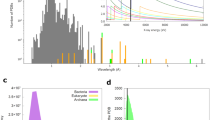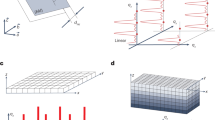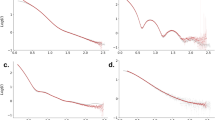Abstract
OVER the past fifty or more years extinction has remained a major experimental problem in crystallography1–3. Many strategies have been devised to reduce its magnitude for the accurate determination of physically-significant structure factors (F). Its elimination, as a practical possibility, has appeared remote because extinction is a concomitant of the production of diffraction intensity in the standard techniques. Phenomenologically, extinction is a manifestation of multiple diffraction (see ref. 4), and this being so, an obvious conclusion is that the experimental disposition to be sought is one where the recorded intensity must arise solely from single-scattering events5–7. Then, by definition, the diffracted beam is not ‘extinguished’ and simple kinematical theory is applicable. Starting with the design of a ‘defocusing’ X-ray monochromator8, I have been investigating the intensity of asymmetric reflections from extended-face crystals over the regions of both positive and negative asymmetry, first with an abraded surface9 and then with an optically flat one. The results from this latter study, with an extrapolation of the work of Hirsch and Ramachandran5, show that it is feasible to establish values of integrated intensity which involve only single-scattering events.
This is a preview of subscription content, access via your institution
Access options
Subscribe to this journal
Receive 51 print issues and online access
$199.00 per year
only $3.90 per issue
Buy this article
- Purchase on Springer Link
- Instant access to full article PDF
Prices may be subject to local taxes which are calculated during checkout
Similar content being viewed by others
References
Bragg, W. L., James, R. W., and Bosanquet, C. H., Phil. Mag., 41, 309–337 (1921); 42, 1–17 (1921).
Conference Report, Acta Crystallogr., A 25, 1–276 (1969).
I.U.Cr.-Aust. Acad. Sci., Diffraction Studies of Real Atoms and Real Crystals, Topic I, 11–127 (Australian Academy of Science, Canberra, 1974).
Darwin, C. G., Phil. Mag., 43, 800–829 (1922).
Hirsch, P. B., and Ramachandran, G. N., Acta Crystallogr., 3, 187–194 (1950).
Gay, P., Acta Crystallogr., 5, 525–530 (1952).
Evans, R. C., Hirsch, P. B., and Kellar, J. N., Acta Crystallogr., 1, 124–129 (1948).
Mathieson, A. McL., J. appl. Crystallogr., 8, 571 (1975).
Mathieson, A. McL., Acta Crystallogr., A 31, 769–774 (1975).
James, R. W., The Optical Principles of the Diffraction of X-Rays, 279 (Bell, London, 1948).
Fankuchen, I., Nature, 139, 193–194 (1937).
Bragg, W. H., Phil. Mag., 27, 881–899 (1914) (reproduced in Acta Crystallogr., A 25, 3–11 (1969).
Author information
Authors and Affiliations
Rights and permissions
About this article
Cite this article
MATHIESON, A. Extinction-free measurements in crystallography. Nature 261, 306–308 (1976). https://doi.org/10.1038/261306a0
Received:
Accepted:
Published:
Issue Date:
DOI: https://doi.org/10.1038/261306a0
Comments
By submitting a comment you agree to abide by our Terms and Community Guidelines. If you find something abusive or that does not comply with our terms or guidelines please flag it as inappropriate.



